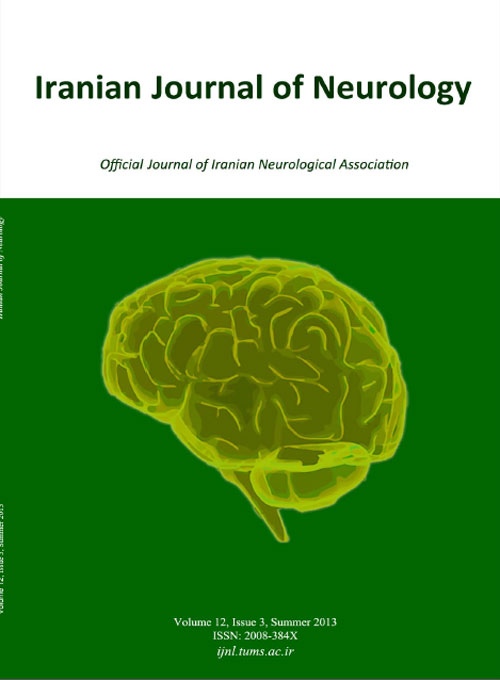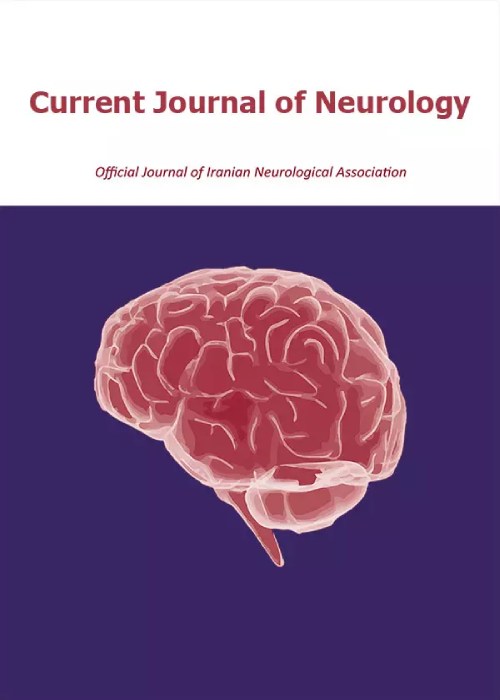فهرست مطالب

Current Journal of Neurology
Volume:12 Issue: 3, Summer 2013
- تاریخ انتشار: 1392/08/17
- تعداد عناوین: 11
-
-
Pages 81-86BackgroundOptical coherence tomography (OCT) is a simple, high-resolution technique to quantify the thickness of retinal nerve fiber layer (RNFL) and macula volume, which provide an indirect measurement of axonal damage in multiple sclerosis (MS). This study aimed to evaluate OCT finding in relapsing-remitting MS patients of the northwest of Iran and compare them with a normal control group.MethodsIn a cross-sectional, descriptive, analytic study, 60 patients with MS as case group and 60 patients as controls were studied. Total macular volume (TMV) and retinal nerve fiber layer (RNFL) in perioptic disk area (3.4 millimeter around the disk) and macula was measured using Stratus 3000 in circular form. These findings were compared between the two groups and their relationship with the duration and severity of MS [based on Expanded Disability Status Scale (EDSS)] and history of optic neuritis were evaluated.ResultsIn total, 35 men and 85 women with a mean age of 34.8 years were evaluated. The mean RNFL in MS patients were 231.9 and 233.1 micrometers in right and left eyes; while they were 246.7 and 250.4 micrometers in right and left eyes of healthy subjects, respectively. This difference in thickness of RNFL in total measure and all quadrants around the optic disk and TMV between case and control groups was analytically meaningful (P = 0.001 and P = 0.001 for right and left eyes, respectively). The mean thickness of RNFL in patients with optic neuritis was significantly lower than other patients in right and left eyes (P = 0.042 and P = 0.005). There was a significant correlation between most of OCT findings and the MS disease duration and EDSS.ConclusionFindings of the present study in the northwest of Iran buttress the idea that RNFL thickness can be greatly affected by MS. Our results also indicate that this effect is associated with ON and MS duration and severity.Keywords: Relapsing, Remitting Multiple Sclerosis, Optic Coherence Tomography, Optic Neuritis
-
Safety assessment of anticoagulation therapy in patients with hemorrhagic cerebral venous thrombosisPages 87-91BackgroundAnticoagulation therapy is a routine treatment in patients with hemorrhagic cerebral venous thrombosis (CVT). However, fear of hemorrhagic complications and deterioration course following anticoagulation often disturbs the responsible physician.MethodsThis was a Prospective observational study on consecutive CVT patients with hemorrhagic venous infarction or subarachnoid hemorrhage (SAH) admitted in Ghaem Hospital, Mashhad, Iran, during 2006-2012. The diagnosis of CVT in suspected cases was confirmed by magnetic resonance imaging/magnetic resonance venography (MRI/MRV), and computerized tomography (CT) angiography following established diagnostic criteria. Demographic data, clinical manifestations from onset to end of the observation period, location of thrombus, location and size of infarction and hemorrhage, and clinical course during treatment were recorded. Choice of the treatment was left to the opinion of the treating physician. Clinical course during 1 week of treatment was assessed based on the baseline modified National Institute of Health Stroke Scale (NIHSS) score. Three or more points decrease or increase of modified NIHSS after 1 week of treatment was considered as improvement or deterioration courses, respectively. Other clinical courses were categorized as stabilization course.Results102 hemorrhagic CVT patients (80 females, 22 males) with mean age of 38.6 ± 8 years were prospectively investigated. Of the 102 hemorrhagic CVT patients in the acute phase, 52 patients (50.9%) were anticoagulated with adjusted dose intravenous heparin infusion and 50 cases (49.1%) received subcutaneous enoxaparin 1mg/Kg twice daily. Decreased consciousness had a significant effect on the clinical course of the patients (X2 = 9.493, df = 2, P = 0.009). Presence of SAH had no significant effect on the clinical course of our anticoagulated hemorrhagic CVT cases (X2 = 0.304, df = 2, P = 0.914). Extension of Infarction in more than two thirds of a hemisphere had a significant influence on the distribution of clinical courses (X2 = 5.867, df = 2, P = 0.044). Difference in distribution of clinical course among the two groups of our hemorrhagic CVT patients was not significant (X2 = 8.14, df = 1, P = 0.87).ConclusionPatients with hemorrhagic CVT without other contraindication for anticoagulation should be treated either with dose-adjusted intravenous heparin or body-weight-adjusted subcutaneous low molecular-weight heparin.Keywords: Cerebral Vein, Thrombus, Hemorrhagic
-
Pages 92-97BackgroundStroke is a heterogeneous disease with several risk factors. High sensitivity C-reactive protein (hsCRP) is a marker for cardiovascular and cerebrovascular diseases. Recent studies have shown that high hsCRP level is a risk factor for ischemic stroke. The objective of our study was to investigate the association of high hsCRP (> 3 mg/L) levels with ischemic stroke and its subtypes in Indian patients.MethodsWe recruited 210 consecutive acute stroke patients and 150 age and sex matched controls. Stroke patients were admitted within 72 hours of onset, at Yashoda Hospital, Hyderabad, India. The study period was from January 2011 to December 2012. All patients underwent tests as per standard protocol for stroke workup. Serum hsCRP level was assessed in all stroke patients and controls on the day of admission.ResultsThe mean hsCRP was significantly higher in stroke patients (3.8 ± 2.5) than controls (1.8 ± 1.5) (P < 0.001). High hsCRP had higher frequency in stroke patients 130 (61.9%) compared to controls 10 (6.6%), P < 0.001. High hsCRP level was more prevalent in the stroke subtypes of cardioembolic stroke (83.3%) and large artery atherosclerosis (72%). High hsCRP level was significantly associated with hypercholesterolemia (P = 0.001), age (P = 0.01), and mortality (0.04). After adjustment of regression analysis it was observed that high level hsCRP is independently associated with acute ischemic stroke (Odds 4.5; 95% CI: 2.5-12.2); especially the stroke subtypes of cardioembolic stroke, (odds ratio 3.4, 95% CI: 1.9-10.5) and large artery atherosclerosis (odds ratio 2.1, 95% CI: 1.5-3.8).ConclusionHigh hsCRP level is strongly associated with and an independent predictor of acute ischemic stroke. The association was found in all ischemic stroke subtypes.Keywords: HsCRP, Ischemic Stroke, Stroke Subtypes, Indian Patients
-
Pages 98-101BackgroundMigraine with aura (MA) has been identified as a risk factor for cardiovascular disease. Previous observation has also found higher prevalence of cardiovascular risk factors in migraineurs without aura (MO), but the results have been conflicting. The present study was conducted to assess the association between cardiovascular risk factors and migraine without aura among Iranians.MethodsIn our study the prevalence of cardiovascular risk factors, including hypertension, hyperglycemia, dyslipidemia, obesity, cigarette smoking, and family history of early coronary artery disease, were studied in 347 migraineurs without aura and 267 non-migraineurs. The odds ratio (ORs) with 95% confidence interval (95% CI) was used to assess the strength of the association.ResultsPatients with migraine without aura were at an increased risk of developing hypertension (ORadj = 1.9; P = 0.029), but there was no difference in other cardiovascular risk profiles, including hyperglycemia, dyslipidemia, obesity, cigarette smoking, and family history of early coronary artery disease.ConclusionOur study revealed that the prevalence of hypertension was higher in migraineurs without aura in comparison with non-migraineurs. Therefore, physicians are supposed to be more vigilant in examining these patients and take care not to prescribe medications that may provoke hypertension.Keywords: Migraine, Hypertension, Aura, Lipid Profile
-
Pages 102-105BackgroundAs a disease of motor nervous system (motor neuron disease), amyotrophic lateral sclerosis (ALS) has a great impact on several aspects of quality of life (QoL). Generic questionnaires of QoL do not address all the especial features of ALS and therefore translation and validation of disease specific questionnaires such as Amyotrophic Lateral Sclerosis Assessment Questionnaire 40-item (ALSAQ-40) is necessary for assessment of patients with different languages. The aim of this study was to review the validation of the Persian version of the ALSAQ-40.MethodsMeticulously translated ALSAQ-40 was completed by 21 ALS patients. Internal reliability was evaluated using Cronbach’s alpha coefficient and item-total correlation was also used to evaluate the correlation of each question with total score. Validity was evaluated through comparison with Amyotrophic Lateral Sclerosis Functional Rating Scale-revised (ALSFRS-r) and the 36-Item Short Form Health Survey (SF-36).ResultsCronbach’s alpha coefficient was 0.91-0.96 for different scales of the ALSAQ-40. All the 40 questions of the questionnaire had correlation greater than 0.5. Correlation coefficient of all the related scales of the Persian version of ALSAQ-40, SF-36 and ALSFRS-r was greater than 0.59 with P value < 0.001.ConclusionMeasures of the Cronbach’s alpha coefficient and item-total correlation demonstrated reliability and consistency of the questionnaire, and correlation coefficients confirmed the validity of different items in the questionnaire. This study showed that the Persian version of the ALSAQ-40 is a reliable and valid questionnaire for the evaluation of QoL in ALS patients with Persian language.Keywords: 40, Item Amyotrophic Lateral Sclerosis Assessment Questionnaire, Cronbach's Alpha Coefficient, Item, Total Correlation, SF, 36 Questionnaire, Amyotrophic Lateral Sclerosis Functional Rating Scale, revised
-
Pages 106-110Mild (140 to 159/90 to 99 mmHg) or moderate (160 to 179/100 to 109 mmHg) chronic arterial hypertension does not appear to cause headache. Whether moderate hypertension predisposes patients to headache at all remains controversial, but there is little evidence that it does. Ambulatory blood pressure monitoring in patients with mild and moderate hypertension has shown no convincing relationship between blood pressure fluctuations over a 24-hour period and presence or absence of headache. However, headaches are associated to various disorders that lead to abrupt, severe, and paroxysmal elevations in blood pressure. In this paper, the secondary headaches attributed to acute crises of hypertension and the criteria for diagnosing each of them have been reviewed. These are headaches attributed to pheochromocytoma, hypertensive crisis without encephalopathy, hypertensive encephalopathy, pre-eclampsia, eclampsia, and acute pressure response to exogenous agents.Keywords: Hypertension, Headache, Hypertensive Encephalopathy, Eclampsia, Pheochromocytoma
-
Pages 111-113A 50 year-old man was referred with history of acute ataxia and lower extremity paresthesia 10 days after general anesthesia with nitrous oxide. Cervical MRI showed long hypersignal lesion in posterior segment of the cord. Blood analysis revealed vitamin B12 deficiency. Nitrous oxide-induced myelopathy should be considered in patients who develop acute neurological manifestation after general anesthesia. It is recommended for physicians to think about symptoms and signs of B12 deficiency when evaluating patients in postoperative visits.Keywords: Ataxia, Spinal Cord, General Anesthesia, Nitrous Oxide, Vitamin B12 Deficiency
-
Pages 114-116Stroke is an important cause of disability and death worldwide, with the majority of strokes occurring in older people. Thrombolysis with recombinant tissue plasminogen activator (r-TPA) is the approved treatment for acute ischemic stroke. A major concern of physicians, who treat acute ischemic stroke with recombinant tissue plasminogen activator (r-TPA,) is the risk of intracerebral hemorrhage. However, other adverse reactions, including anaphylaxis and angioedema, can also occur. Here we report an interesting soft tissue reaction to intravenous r-TPA in an 80 year-old male who was treated for acute ischemic stroke.Keywords: Acute Ischemic Stroke, Thrombolytic Therapy, Allergic Reaction
-
Pages 117-118


